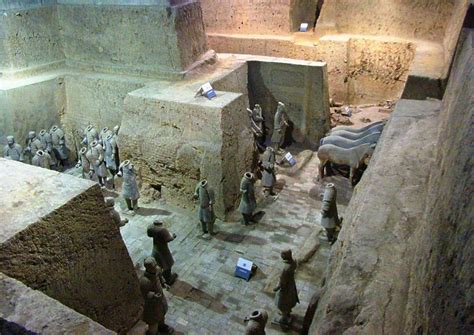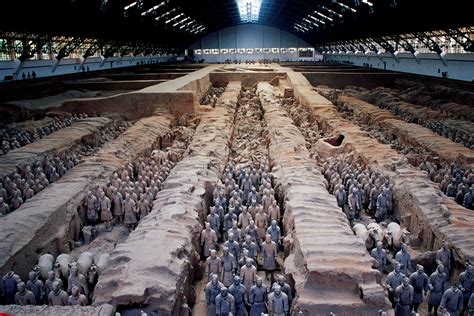ancient china excavation Near the unexcavated tomb of Qin Shi Huang —who proclaimed himself first emperor of China in 221 B.C.E.—lay an extraordinary underground treasure: an entire army of . John Deere offers six models of compact excavators with operating weights ranging from 1.7 to 6 metric tons. Find the mini digger that suits your needs and budget, and explore the attachments and features available.
0 · tomb of china
1 · clay army mausoleum china
2 · china artifacts
3 · china archaeology wikipedia
4 · china archaeology facts
5 · ancient china wikipedia
6 · ancient china tomb
7 · ancient china archaeology
Bobcat 331 MINI Excavators Equipment for Sale. View | View Used | View States | About Bobcat 331 Excavators Equipment. Available Colors. Looking to buy a Bobcat 331 excavators? Browse our extensive inventory of new and used Bobcat 331 .
Archaeologists excavated 200 more clay soldiers and weapons from the mausoleum of Emperor Qin Shi Huang, who ruled China 2,000 years ago. The figures, each with unique features, were part of a.
The tomb of Qin Shi Huang, China's first emperor, is a city-size complex of underground caverns with clay soldiers, concubines and treasures. Learn about the history, .In the 20th century, archaeologists made tens of thousands of discoveries in China. In 2001, the Institute of Archaeology of the Chinese Academy of Social Sciences organized a poll of experts who selected China's 100 major archaeological discoveries in the 20th century, with Yinxu receiving the most votes. One of the archaeological discoveries of China is a Guanyindong Palaeolithic cave site, discover.
Near the unexcavated tomb of Qin Shi Huang —who proclaimed himself first emperor of China in 221 B.C.E.—lay an extraordinary underground treasure: an entire army of . A 3,000-year-old cemetery containing the tombs of a wealthy clan has been uncovered in central China following two years of excavation by archaeologists.
Archaeology is the study of the material remains of humanity’s past. Excavated materials, along with other historical objects and text records, form the primary source material on Ancient China. Archaeologists on Monday announced the "significant" series of finds at the Sanxingdui ruins in China's southwestern Sichuan province, according to the team behind the . Qin tomb is the burial place of the first Qin emperor, Shihuangdi, who unified China and built the Great Wall. It contains a vast underground palace, a terra-cotta army, and other treasures, some of which are still unexcavated. Archaeologists discovered three remarkable 1,800-year-old, residential-style tombs featuring rooms and windows, where an ancient Chinese family was laid to rest .
The city of Xian was home to 13 royal dynasties and remained the capital of ancient China for 1,100 years. Late in 2001 Chinese scientists announced they had found the .
Archaeologists excavated 200 more clay soldiers and weapons from the mausoleum of Emperor Qin Shi Huang, who ruled China 2,000 years ago. The figures, each with unique features, were part of a. The tomb of Qin Shi Huang, China's first emperor, is a city-size complex of underground caverns with clay soldiers, concubines and treasures. Learn about the history, mysteries and dangers of.An overview of the history, methods, and discoveries of archaeology in China, from ancient times to the present. Learn about the role of scholar-officials, the challenges of Western origin theories, and the 100 major archaeological finds in the 20th century.
Near the unexcavated tomb of Qin Shi Huang —who proclaimed himself first emperor of China in 221 B.C.E.—lay an extraordinary underground treasure: an entire army of life-size terra-cotta.
A 3,000-year-old cemetery containing the tombs of a wealthy clan has been uncovered in central China following two years of excavation by archaeologists.Archaeology is the study of the material remains of humanity’s past. Excavated materials, along with other historical objects and text records, form the primary source material on Ancient China. Archaeologists on Monday announced the "significant" series of finds at the Sanxingdui ruins in China's southwestern Sichuan province, according to the team behind the dig and the state-run. Qin tomb is the burial place of the first Qin emperor, Shihuangdi, who unified China and built the Great Wall. It contains a vast underground palace, a terra-cotta army, and other treasures, some of which are still unexcavated.
Archaeologists discovered three remarkable 1,800-year-old, residential-style tombs featuring rooms and windows, where an ancient Chinese family was laid to rest alongside their treasured. The city of Xian was home to 13 royal dynasties and remained the capital of ancient China for 1,100 years. Late in 2001 Chinese scientists announced they had found the tomb of Li Chi, a princess from the Tang Dynasty (618 - 907 AD) and only one year later the same team of researchers unearthed the tomb of Zhang Tang, a top judicial official of . Archaeologists excavated 200 more clay soldiers and weapons from the mausoleum of Emperor Qin Shi Huang, who ruled China 2,000 years ago. The figures, each with unique features, were part of a.
guide lugs asv skid steer
The tomb of Qin Shi Huang, China's first emperor, is a city-size complex of underground caverns with clay soldiers, concubines and treasures. Learn about the history, mysteries and dangers of.An overview of the history, methods, and discoveries of archaeology in China, from ancient times to the present. Learn about the role of scholar-officials, the challenges of Western origin theories, and the 100 major archaeological finds in the 20th century. Near the unexcavated tomb of Qin Shi Huang —who proclaimed himself first emperor of China in 221 B.C.E.—lay an extraordinary underground treasure: an entire army of life-size terra-cotta. A 3,000-year-old cemetery containing the tombs of a wealthy clan has been uncovered in central China following two years of excavation by archaeologists.
Archaeology is the study of the material remains of humanity’s past. Excavated materials, along with other historical objects and text records, form the primary source material on Ancient China. Archaeologists on Monday announced the "significant" series of finds at the Sanxingdui ruins in China's southwestern Sichuan province, according to the team behind the dig and the state-run. Qin tomb is the burial place of the first Qin emperor, Shihuangdi, who unified China and built the Great Wall. It contains a vast underground palace, a terra-cotta army, and other treasures, some of which are still unexcavated.

Archaeologists discovered three remarkable 1,800-year-old, residential-style tombs featuring rooms and windows, where an ancient Chinese family was laid to rest alongside their treasured.
tomb of china

Browse 446 incredible Mini Excavator vectors, icons, clipart graphics, and backgrounds for royalty-free download from the creative contributors at Vecteezy!
ancient china excavation|china artifacts